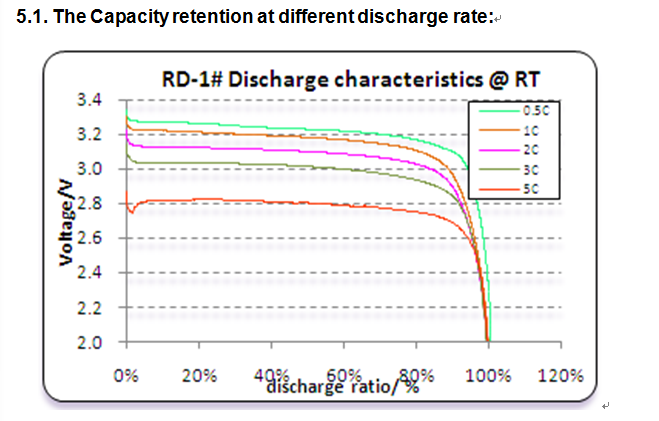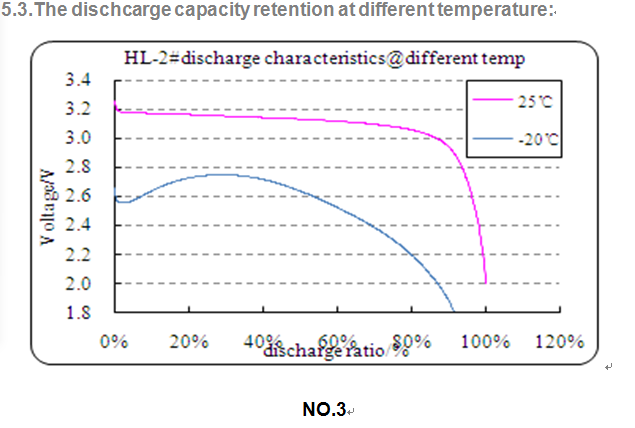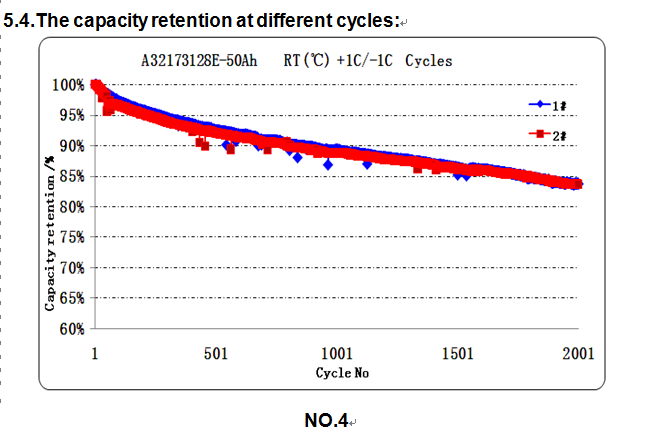Shenzhen Topband Battery Co., Ltd |
|
| No. | item | standard | remark |
| 2.1 | Nominal Capacity | 100Ah | 25±5℃,0.5C discharge |
| 2.2 | Internal Impedance | ≤0.3mΩ | |
| 2.3 | Nominal Voltage | 3.2V | |
| 2.4 | Weight | 2600±20g | |
| 2.5 | Max charge Voltage | 3.65V | At CC mode |
| 2.6 | End-of-charge Current | 0.05C | At CV mode |
| 2.7 | Cut-off discharge Voltage | 2.00V | |
| 2.8 | Standard Charge Method | 0.5C CC/CV | 25±5℃ |
| 2.9 | Max continuous discharge current | 3C | Recommend 2C |
| 2.10 | Max pulse Discharge Current | 5C | Discharge Time: 10 seconds |
| 2.11 | Cycle Life | 2000cycles @100% DOD | At room temperature 25℃; 1C Continuous Discharge and 1C continuous charge current; ≥80% SOC (100% DOD) 25±5℃ |
| 2.12 | Calendar Life | 8years | |
| 2.13 | Charging Temperature | 0~45℃ | |
| 2.14 | Discharging Temperature | -20~55℃ | |
| 2.15 | Storage Temperature | -10~30℃ | |
| 2.16 | Terminal torsion | ≤5.5N·m | Locknut is recommended |
| 2.17 | Appearance | Without break, scratch, distortion, contamination, leakage and so on | |
The "Standard Charge" means in an ambient temperature of 25℃±5℃, the cell was discharged with 0.5C constant discharge current to cut-off voltage 2.0 V, standing 1h, then charged it with 0.5C constant current to 3.65V, then charge mode turn into CV mode, until the charging current is down to 0.05C, then end of charging and standing 1h.
| item | Test method | Criteria |
4.1 High Temperature Discharge Performance | The cell was charged in accordance with 3.2, and stored in an ambient temperature of 55℃±3℃ for 5h, then discharged to cut-off voltage with a constant current of 1C. After that, fetch out the cell and place it in the ambient temperature of 25℃±5℃ for 4h then check its appearance. |
Capacity retention at 55℃ :≥95% |
4.2 Low Temperature Discharge Performance | The cell was charged in accordance with 3.2,and stored in an ambient temperature of -20℃±3℃ for 24 hours, then discharged to cut-off voltage 1.8 V at a constant current of 1C. After that, fetch out the cell and place it in the ambient temperature of 25℃±5℃ for 4hours, then check its appearance. | Capacity retention at -20℃ :≥70% |
4.3 Rate Charge Performance in Normal Temperature | Under the ambient temperature of 25℃±5℃ a. Discharged the cell with 1C constant current until the cut off voltage to 2.0V, stay for 1h. b. Charged the cells with 2C constant current until the voltage to 3.65V, stay for 1h. c. Discharged the cells with constant current until the cut off voltage 2.0V. | 2C charge capacity≥80% |
| 4.4 Rate Discharge Performance in Normal Temperature | The cell was charged in accordance with 3.2, then discharge to cut-off voltage 2.0V with 3C current in an ambient temperature of 25℃±5℃. | 3C discharge capacity≥95% |
4.5 Cycle Life (25℃±5℃) | The cell was fully charged to 3.65V with 1C (cc/cv), after that stayed for 30min; Subsequently, the cell was discharged to cut-off voltage 2.0V with constant current 1C, and stayed 30 minutes; prior to next charge-discharge cycle. Record all the cycles until the retention capacity<80%. | ≥2000cycles |




6. Environmental Characteristics
No . |
Item |
Test Method |
Criteria |
6.1 |
Temperature shock test |
A cell is charged in accordance with 3.2, and then repeat the following procedures for 5 cycles, then check the cell's appearance.
|
No leakage, no fire, no explosion, no vent |
6.2 |
Low-pressure Test |
The cell is charged in accordance with 3.2, then stored for 6h at a vacuum of -90KPa, after that put the cell in room temperature for 6h, then check the cell's appearance. |
No leakage, no fire, no explosion, no vent |
6.3 |
Vibration Test |
The cell is charged in accordance with 3.2, and then installed onto the vibration machine. Equipment parameters of frequency and amplitude are set as bellow (the frequency is to be varied at the rate of 1oct/min between 10 and 55 Hz, and repeat vibration for 30 min. The cell is tested in three mutually perpendicular directions, i.e. X,Y,Z):
|
not less than 3.2V. |
6.4 |
Shock Test |
The cell is tested in accordance with 3.2, and then secured to the testing machine by means of rigid mount which supports all mounting surfaces of the cell. Each cell shall be subjected to a total of three shocks of equal magnitude. The shocks are to be applied in each of three mutually perpendicular directions. The acceleration and impulse time are as follows: acceleration of impulse peak value: 100m/s2, shock frequency:40~80 times/min, impulse lasting time:16 min, shock times:1000±10 |
|
7. Safety test
All below tests are carried out on the equipment with forced ventilation and explosion-proof device. Before test, all cells are charged in accordance with 3.2, and stored 24h prior to test.
| No. | Item | Test Method | Criteria |
7.1 |
Short- circuit Test | The cell was charged accordance with 3.2, after that the cell is short-circuited by connecting the positive and negative terminals with a wire for 10min, the wire has a maximum resistance load of 5mΩ., then observe for 1h. |
No fire, no explosion |
7.2 |
Overcharge Test |
The cell was tested in accordance with 3.2, then 1C constant current charged till the voltage reaches 1.5 times of the specified end-off charge voltage, or the charge time reaches 1h, then stop charge, and observe for 1h. |
No fire, no explosion |
7.3 |
Over discharge test |
The cell was tested in accordance with 3.2, then 1C discharge for 90min, then observe for 1h. |
No fire, no explosion, no leakage |
7.4 |
Crush Test | The cell was tested in accordance with 3.2, and then is placed on the crush machine, the axis is parallel to the crush equiment, and it is crushed between two flat surfaces till the crushing force is gradually approaching 200 kN, or voltage reaches 0V,or reaches 30% distortion, then observe for 1h. |
No fire, no explosion |
7.5 |
Impact Test | The cell was tested in accordance with 3.2, and then placed on the impact flat. A Φ15.8mm bar is to be placed on the center of the cell. A 9.1kg weight is dropped from a height of 610mm onto the cell, the distortion is allowed. |
No fire, no explosion |
7.6 |
Stick Test |
resistance steel needle, with speed of 25±5mm/s, to go through the cell from vertical direction of pole plate, the penetrate position should be close to the geometric center of plate surface, the steel needle remains in the cell; |
No fire, no explosion |
7.7 |
Heating Test(130℃) | The cell was tested in accordance with 3.2, and then heated in a circulating air oven. The temperature of the oven is raised at a rate of 5℃ per minute to 130℃±3℃ and remain for 30 min. |
No fire, no explosion |
8,Dimension (Unit:mm)
